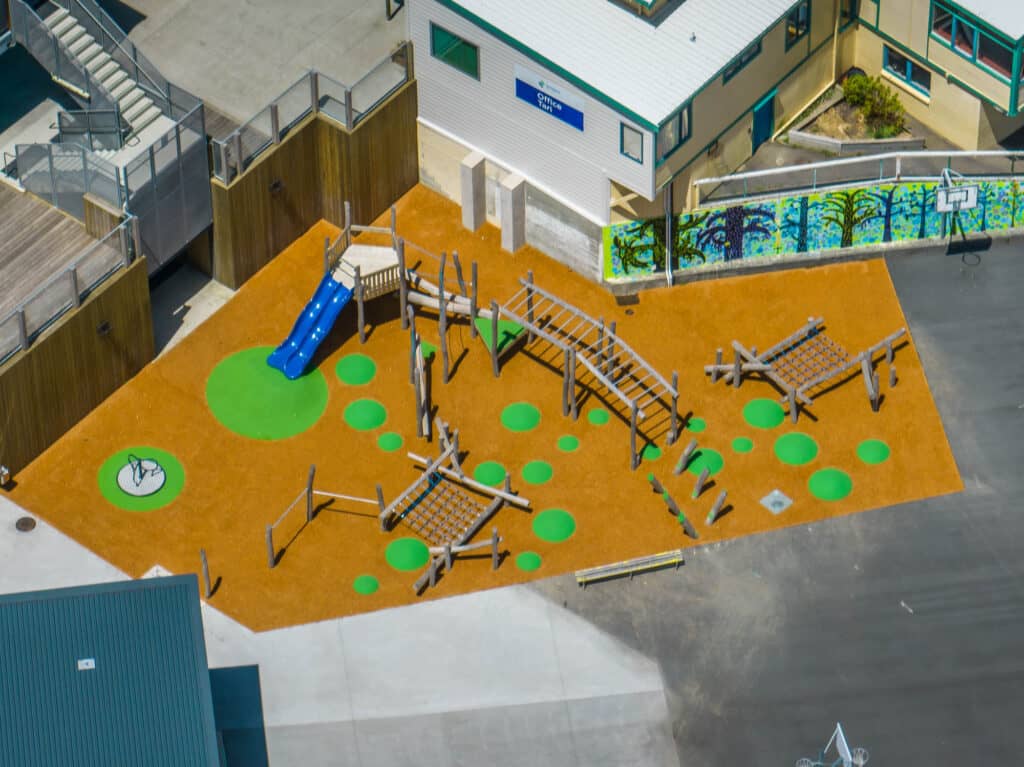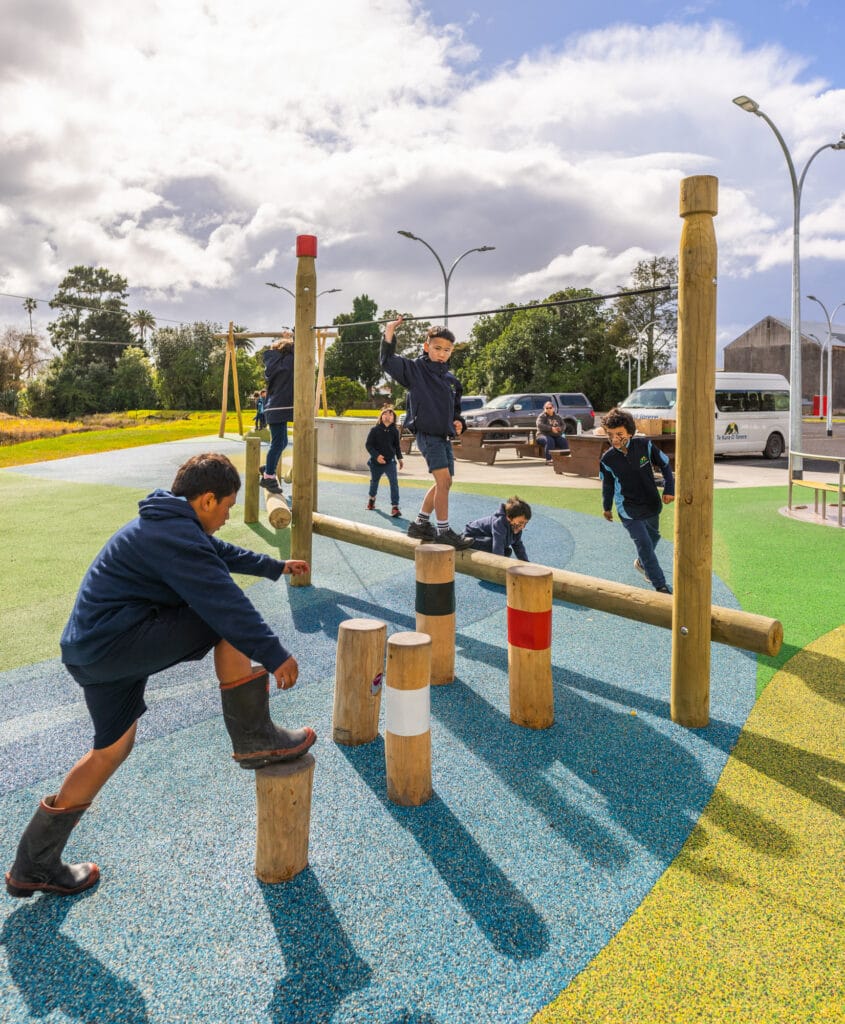Our latest guide is out, and it’s ready for you to dive into all the information we’ve gathered for your next project. So, if you’re just starting your journey on how to build a playground for your area, or if you’re ready to hit the start button on your project and want to gather a few more details, this guide is perfect for you!
Options for Building a Playground
When it comes to playground design, you can choose between three main options: the Full-service Playground Builder Option, the Multi-Company Option, or the ‘No Design’ Option. Each has its unique qualities and considerations, and you can check them fully in our guide.
How Much Does a Playground Cost?
Building a playground is like buying a house; the playground cost depends on various factors. Costs for school, early learning centre, and council playgrounds are provided, along with considerations for budgeting design, equipment, surfacing, and site preparation. The costs can range from $450 to $1100 per m2, depending on the type of playground and equipment you require for your space.
Design Budget
- Community Consultation: Including a process to gather ideas from the community ensures the playground meets local needs but may increase time and cost.
- Number of Concept Designs: Deciding whether to have multiple concept designs or just one affects the cost; more designs will be more expensive.
- Incorporation of Cultural or Local Themes: Adding cultural or local themes can enhance the design and increase the cost due to complexity.
- Working with a Single Company for Design and Construction: Choosing one company for both design and construction can reduce overhead costs, potentially making the project less expensive.
Play Equipment Budget
- Reuse of Existing Equipment: If current equipment is in good condition, reconfiguring or reusing it can save part of the budget.
- Play Types Needed: Consider the types of play (e.g., sliding, swinging, climbing) you want in the space, as this will affect the design.
- Equipment Lead Times: Long lead times on equipment can impact the project’s timely completion and may affect costs.
- Hidden Installation Costs: Consider hidden costs like freight and installation of equipment.
- Maintenance Costs: Account for ongoing maintenance costs, including surfacing, equipment, and landscaping.
- Off-the-Shelf vs. Customized Equipment: Choosing between ready-made or customized equipment will impact lead times and cost.
- Material Choices: The materials used (e.g., plastic, metal, wood) will significantly affect the cost of the playground.
- Shade Installation: Shade sails may be necessary for sun-exposed areas, adding extra cost.
- Outdoor Furniture Requirements: Consider if seating or other outdoor furniture is needed for those supervising children in the playground.
You can read more about the play equipment budget by clicking here.
Surfacing Budget
- Fall Height of Equipment: Higher equipment may require more spending on safety surfacing to ensure safety.
- Existing Surface Condition: If the existing surface needs clearing, demolition, or drainage work, it will increase the project’s cost.
- Inclusivity and Accessibility: Consider whether the playground needs to be wheelchair accessible, as some low-cost surface options may not be suitable.
- Ongoing Surfacing Maintenance: Different surfaces require varying maintenance levels; for example, wood chips need annual topping up, while wet pour rubber requires little maintenance.
- Impact of Loose Safety Surface: Consider whether loose material spilling out will affect adjacent areas’ usability.
- Inclusion of Surface Mounds and Topography Play: Only specific surface options allow for this level of design complexity.
- Themed Surface Design: Adding a theme to the surface design will increase the cost.
- Landscaping Surrounding Area: Including garden areas adds character and increases cost.
You can read more about the surfacing budget by clicking here. Also, check our surfacing page for more details on surfacing by clicking here.
Site Preparation Budget
- Removal of Existing Equipment and Surfacing: Consider whether any existing elements need to be removed or disposed of, as this can affect the project’s timeline and cost.
- Drainage Issues: Addressing existing drainage problems is essential to prevent future issues and may add to the cost.
- Retaining Walls: Assess whether retaining walls need to be replaced or built, as this can impact the project’s complexity.
- Existing Trees and Roots: Working around or removing trees and roots may require special consideration and can affect the design and cost.
- Underground Services: Be aware of any water, gas, or power lines under the space that may need to be worked around.
- Access for Trucks and Equipment: Ensure the space is accessible for construction vehicles, as limited access may complicate the construction process.
- Pedestrian Traffic: Consider how pedestrian traffic will be managed during construction, especially if the site is busy.
- Project Staging: Decide whether the project will be completed in stages or all at once, as this can affect the timeline and coordination of the project.
You can read more about the surfacing budget by clicking here.
Remember, to build your playground is always important to separate your project into three parts! Read more by downloading our guide.

Choosing the Right Type of Playground
Desired Aesthetic
The aesthetic of a playground depends on the materials used. Striking the right balance between plastic, rubber, metal, wood, and natural fibres is essential.
Level of Inclusion & Accessibility
Creating a fully inclusive and accessible playground requires consideration of equipment, materials, sensory elements, and smooth safety surfacing. Read all about inclusive playground design by clicking here.
Age Range Catered For
Designing for different age groups requires careful consideration of equipment size, expense, and additional features like seating for supervising adults.
Level of Custom Design
Building a playground can be about creating a community space. Incorporating cultural reference points and unique touches adds value.
Range of Play Types
Consider the children using the playground and the types of play they require. Different play types like swinging, climbing, and balancing must be considered.
Valuable insights and guidance. Whether you’re a school, early childhood centre, or public space, the principles outlined here can help you create a playground that meets the needs of your community.
Which Playground Companies are Best?
Playground Designers, Equipment Suppliers, and Surfacing Suppliers
When building a playground, you may work with different companies for design, equipment, and surfaces. Creo offers a full-service option, providing all these services under one roof. They share five reasons why they decided to become a Full-service Playground Builder and include testimonials from recent customers.
What's the Best Way to Build a Playground?
- Site Mapping with Drone and 3D Scan Technology: The process begins with an on-site meeting to discuss ideas, budgets, and needs. Drone technology is then used to take 3D shots, mapping out the entire space.
- Concept Design: Sketches of one or two play space options are created for discussion, leading to a final plan and budget.
- Detailed Design and 3D Render: The design details are drawn, and a walkthrough 3D render is presented, showing how the site will be constructed.
- Equipment Procurement and Manufacturing: Necessary materials are gathered and manufactured, and preplanning is done to ensure smooth construction.
- Site Preparation: The first stage of construction involves excavation and readying the site levels.
- Construction: Paths, structures, and other items are created, transforming the space from a grey construction site into a bright, usable area.
- Finishing: The project is completed with sanding, planting, and installing final items.

Common Mistakes When You Build a Playground
Mistake #1: Overlooking User Experience
- Consider shelter, seating, shade, surfacing temperature, and slide orientation to avoid safety issues or discomfort.
Mistake #2: Unclear Budget
- Agree on a budget early to avoid issues like compromising quality and safety. Consider costs like site setup, demolition, retaining walls, drainage, shade installation, landscaping, and cleaning.
Mistake #3: Non-compliance Issues
- Always follow guidelines and standards like NZS 5828:2015, ensuring sufficient safety surfacing, spacing between equipment, and avoiding potential entrapments.
Mistake #4: Overlooking Inclusive Equipment
- Decide early if the play space needs to be accessible for all abilities and plan the budget accordingly.
Mistake #5: Lack of Flow and Connection
- Ensure a sense of flow and connection between different elements, considering site lines, equipment arrangement, entry and exit points, equipment spacing, and positioning of potentially dangerous elements.
Mistake #6: Overemphasis on Aesthetics
- Balance aesthetics with play value, ensuring the budget is allocated to maximize fun and excitement rather than non-playable features
Thoughts on how to build a playground
This guide is your handbook to go from idea to execution with Creo. We wanted to be thorough so your decision to push start your playground design and build project is more manageable and smoother.
Read our portfolio below if you want to know more and get inspired. Or if you are ready to decide, call us on 0800 000 334 or book a site visit.

